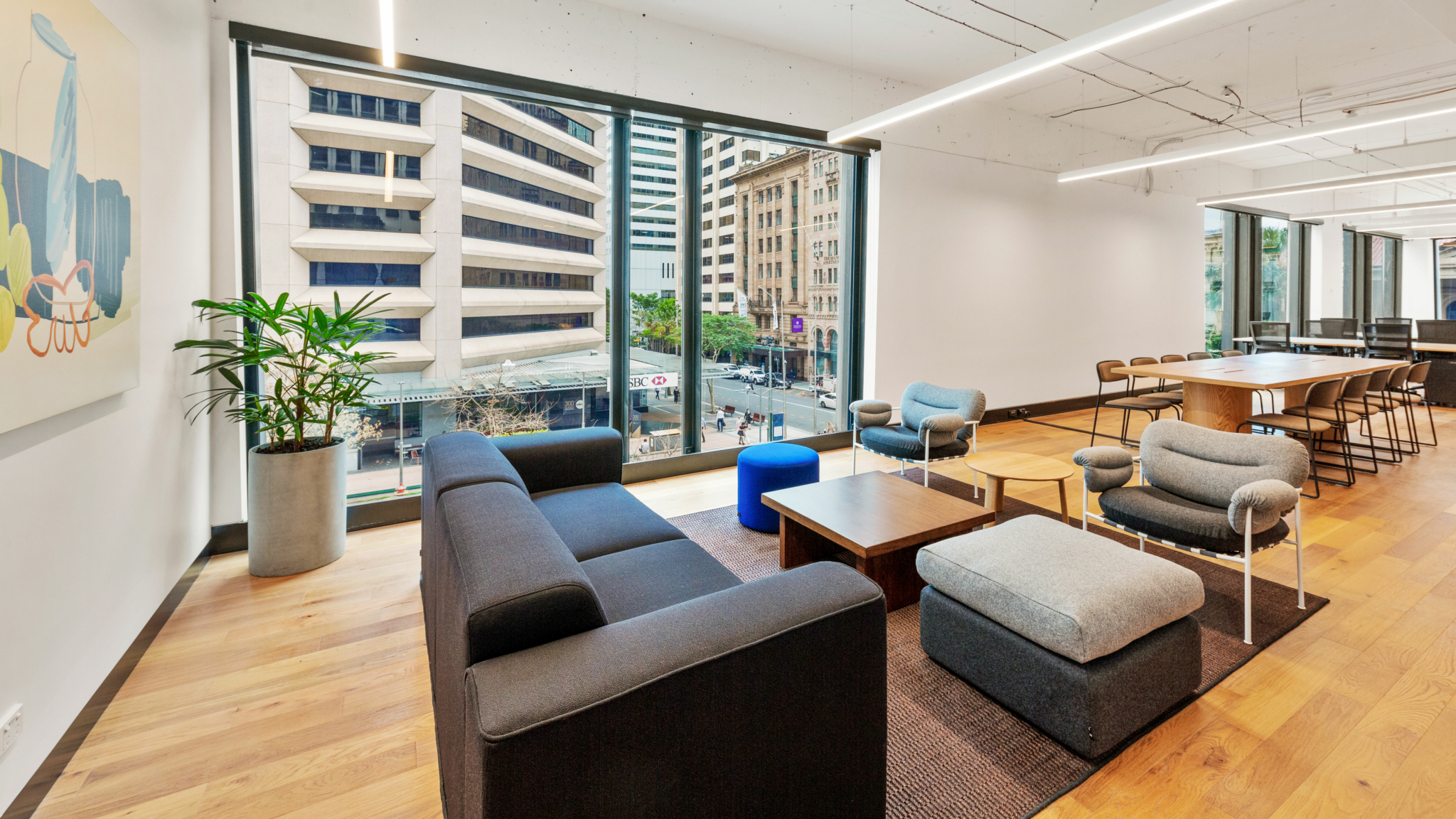When the COVID-19 pandemic swept across the United States in March and April last year, the U.S. federal government, the largest employer globally, moved faster than many of the world’s leading private sector businesses when it came to remote work.
Because of this speed, major federal agencies and their subsidiaries had to consider how to have a federal workforce work efficiently from their living rooms or a more convenient workspace location.
They had to ask: How do you balance the new normal of flexible work with one of the largest commercial office space footprints in the world? The answer to that question is evolving, but the future of flexible work in the public sector looks bright for both federal employees and the American taxpayer.
To provide some insight into how the U.S. General Services Administration (GSA), an independent federal agency that oversees the government’s real estate footprint, is thinking about this evolving answer, WeWork connected with Tim Horne, former GSA acting administrator and a 27-year veteran of federal commercial real estate, to give us a peek under the hood.
WeWork: Now that hundreds of thousands of federal employees have proven themselves to be efficient working remotely, how do agencies balance in-person and remote work?
The long-term impact of the dramatic and overnight move to mobile work has yet to be determined. On the one hand, managers and employees who weren’t previously inclined to work remotely have developed the skills and tools necessary to get their work done away from the office. On the other hand, not all agency missions lend themselves to remote work. As the option to return to facilities becomes a reality, managers and employees will likely seek a more balanced approach.
As much as the federal government has flexed its mobile work muscles and enhanced the tools available to the workforce, the inability to go to an office is sure to undermine effectiveness over the long term. I sense that we won’t see a return to the work styles of 2019, but the majority of the workforce won’t work as they did in 2020 either.
It’s no secret that the federal government wants to recruit a more technologically proficient workforce. Will this inform and drive department strategies?
The federal personnel system makes it difficult to compete for top talent. Just about every administration has civil service reform on their agenda. While the Biden administration gets a plan in place, increased flexibility in duty stations will have a positive impact on recruiting across the federal government.
Are you expecting a de-densification or decentralization approach from the GSA? Could it be both?
It is too early to tell. However, I guess that the initial reaction will be to move toward decentralization. But as workers begin to return to facilities, I expect that there will be a more balanced and measured approach. The trend toward a smaller, more efficient real estate footprint is here to stay, but I would say social distancing concerns will have an impact on how quickly the GSA works to cut down on inefficient utilization rates.

To date, increased density has been the main tool in cutting real estate costs. With that tool considered to be less desirable, strategic planning and a big focus on requirements development along with flexible housing strategies will move to the forefront.
Do you feel that an overemphasis on remote work will harm opportunities for cross-department and agency collaboration?
It is all about balance. Suppose the federal government employs a thoughtful and methodical approach to portfolio management. In that case, it will be possible to have the best of all worlds—collaboration, creativity, cost savings, and mission effectiveness. If it becomes a knee-jerk reaction and it’s determined that we don’t ever need to be in the office because we made it work through the pandemic, then I think trouble is on the horizon.
The GSA manages the massive repair liability across federal building inventory. Are you expecting project delays due to the pandemic?
The GSA has an incredibly talented and dedicated workforce, but they also face the challenge of massive repair liability across the inventory. Until Congress fully funds the GSA’s repair and alterations program, this trend will continue. That means that despite the great work from the GSA team, those project delays are inevitable.
The Biden administration wants to prioritize sustainability. How will that impact the GSA and other federal real estate stakeholders?
Early signs indicate that sustainability will be a key part of the Biden management agenda. That agenda will likely lead to an investment in green technology across leased and government-owned inventory, and it will likely continue the work that started with the American Reinvestment and Recovery Act (ARRA) and Obama-era policies. Any stimulus legislation will likely include a significant number of projects that improve energy efficiency in federal assets.
Considering the pandemic, is there still an opportunity for the GSA to be more efficient with their layouts?
The GSA has made great strides over the past five to 10 years in improving the performance and efficiency of its portfolio—it has done tremendous work on behalf of the taxpayers. Over the past 11 months, the GSA has mobilized to keep the work environment safe and operational for federal workers who need to report to the office.

True to form, WeWork is also an industry leader in this area. WeWork’s health and safety measures, response plans, and space modifications have been independently audited and endorsed by Bureau Veritas, and have been awarded a certificate of conformity. Bureau Veritas is an internationally recognized testing, inspection, and certification organization. The GSA and the federal government have the opportunity to jump-start their return to facilities plan by studying industry leaders like WeWork.
How can the GSA leverage WeWork when confronted with a federal building project delay?
WeWork is an industry leader in creating work environments that add value and increase workplace efficiency and effectiveness. WeWork’s approach means that the GSA and federal agencies can short-circuit the lengthy planning and requirements development process and quickly move into modern and well-designed spaces on a short-term or long-term basis.
You have become more familiar with WeWork over the past year. Where do you see WeWork’s flexible work solutions helping federal real estate stakeholders the most as they move into a post-COVID-19 landscape?
WeWork’s value add is the ability to package real estate, furniture, IT, and change management in a way that is easy to buy. WeWork has the opportunity to add value by providing federal real estate professionals the same ease and flexibility that cloud computing brings to IT professionals.
WeWork and the GSA are not that different when it comes to searching for longer-term leases to pass savings down to the end user or federal tenant. What do you think the two entities could learn from each other?
WeWork and the GSA share the mission of creating work environments that make it easier and more enjoyable for people to do their work, and they both operate at a massive scale. The GSA has been around since 1949, so WeWork could undoubtedly benefit from its long history and the comprehensive planning and portfolio management expertise that exists at the GSA. WeWork has developed in-depth knowledge of how to deliver turnkey work environments quickly. Specifically, WeWork adds value because it can:
- Provide flexible locations, so employees can work near their homes
- Enhance continuity efforts and increase overall efficiency by decentralizing the footprint through a hub-and-spoke model
- De-densify the footprint and add additional space on a flexible term to enable social distancing
Where can WeWork play an impactful role in enabling the future of federal work?
Managing a real estate portfolio as large and diverse as the federal government’s is a tremendous challenge. WeWork’s innovative approach and thought leadership would add tremendous value to the GSA’s efforts to continue to support the needs of the federal workforce. WeWork’s additional tools can help the GSA and the federal government more effectively manage the federal portfolio. WeWork’s consultative approach to creating a more efficient footprint can supercharge GSA’s efforts to rightsize lease portfolio and provide much-needed flexibility to GSA’s post-COVID-19 real estate strategy.
WeWork Federal is the best-in-class flexible workplace provider, and has supported the U.S. Air Force, U.S. Army, and other major federal and defense tenants. Visit WeWork Federal to learn more.
Traug Keller is the director of WeWork Federal, a team dedicated to enhancing the U.S. federal government’s workspace strategy. Prior to this role, he managed WeWork’s portfolio in the National Capital Region.
Rethinking your workspace?










